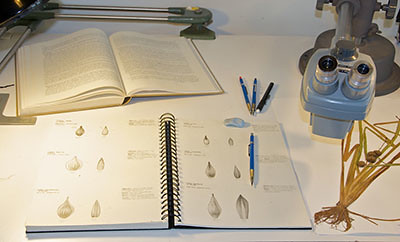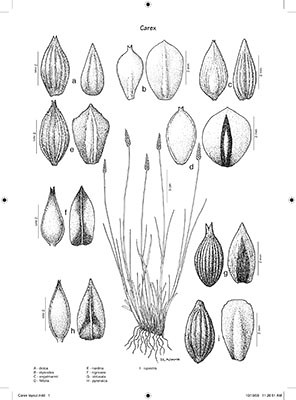Friday, March 12, 2010
Where is that "Rich" guy?
First off, let me apologize for the extended absence from my website, newsletters, and life in general. I am still alive, and yes, I am still drawing. I have been fortunate to have picked up a couple of projects that are keeping me very busy with very little free time for the last several months. I'll talk a bit more about them in an upcoming blog post but wanted to provide a brief update on what I've been working on.
Botanical Illustration
I was approached at the end of 2008 (see my website for the approximate point where I stopped posting) by a botanist from the University of Montana who was looking for an illustrator for a project he is working on. He had worked with a couple of other illustrators in town and was looking for someone to work on the final phase of the project. I freely admitted that my knowledge of plants was fairly limited but I was a sucker for punishment. He recommended we arrange a meeting to talk about the project and what he was looking for.
We discussed the project in detail and it sounded like a great opportunity to 1) expand my knowledge of the flora of Montana, 2) get back to some scientific illustration similar to what I loved doing in the early 90's, and 3) pick up a technical pen again for the first time in over 15 years.
The project is being funded by the US Forest Service through the Montana Native Plant Society and will culminate in the publication of a book at some point in 2010. The book is aimed at botanists more than the general public. There are a gazillion illustrations for the book and I signed on for the final 18-months of work. I have been working feverishly to be finished ahead of the deadline so there will be plenty of time for revisions, changes, or additions prior to going to press.
I have really enjoyed the work and have learned a lot about numerous genera of plants. I am hopeful that this experience can lead to other botanical illustration projects or other illustration projects in general.
Technical Aspects
I adopted a two-stage approach to the illustrations where I draw a fairly refined pencil drawing of each of the species. This is done in my favorite sketchbook, the Canson Field Drawing Book. The paper in the sketchbook is quite durable, allowing fairly easy erasing of allows me to draw fairly quickly but easily allows for fine details. There is a similar sketchbook called the Canson Field Sketch Book but the paper in it is quite thin and not nearly as resilient.
Once these semi-finished drawings are completed, I transfer the outlines to a bristol paper. After trying out about 10 different papers for use with pen & ink I settled on Strathmore 500 Series Vellum. Because it is cotton-based, it works great with pen & ink and I find myself using it for more pencil illustrations as well. I happened to have some of this paper on hand but I have to admit that cartoonist Tom Richmond really demonstrates why it is so useful for pen & ink.
The shading is done with stippling which is totally different than pencil work. Not only is it far more time-consuming, it also requires you to use the appropriate pen nib size. I frequently rely on a 0.25mm technical pen (Rapidograph 3x0 for those geeks out there) as it is very durable and can withstand the constant tap-tap-tapping caused by the thousands of tiny little dots.
An Abstruse Lexicon
I am just over the two-thirds point of the project and am starting to feel like I am beginning to learn a bit about plants. Oh, for those who've never taken a botany course in college or read a scientific journal, the technical jargon for various plant parts are simply mystifying. I'm not versed in Latin nor in botany so I keep my dictionary handy to look up "hard words". Examples include words like "hirsute", "campanulate", "foveate", along with a host of other "grown-up" words. Oh, by the way, the term "abstruse" used in the title of this section means "difficult to understand", it's a perfect way of summing up my feelings about botanical jargon.
I've created a separate Botanical Illustration page on my Drawings page. The four 'Carex' drawings begin to show true stippling techniques and will resemble the majority of remaining illustrations. The drawings may at some point be offered as prints and the finished book will be available sometime next year.
More information to come about additional botanical illustrations...
Technorati Tags:
botanical, illustration, drawing
Subscribe to:
Post Comments (Atom)


2 comments:
Why botanical illustrations, and not simply photographs? Classier?
Great question. Not to come to the defense of my work too quickly, but there are four primary reasons that make line art more useful than images.
First: it is difficult to single out the defining characteristics of a plant with a photograph. Since the entire image is equally "resolved" no single feature is more prominent. Illustration allows for important features to receive details while less important features don't. When botanists are defining the morphological features of various grasses, they are looking for things like hair density or teeth along the calyx. They are not nearly as interested in other features and in fact including them makes it more difficult to tell them apart.
Second: The items being drawn are of very small scale in many cases. Some of the major features are 2-3 mm long with details being 0.2mm or even smaller in size. These details are nearly impossible to photograph without specialized equipment.
Third: It is quite difficult to effectively light an object that you are photographing from 1 or 2 cm away. There's simple no way to fit a flash or off-camera light into the space between the lens and the object.
Fourth: and probably most importantly, it is very difficult to scale photographs either by enlarging or reducing while maintaining integrity. This is why black and white line drawings are more easily scaled than other forms of artwork, especially for print media. There's less information to scrunched up by the process.
Good question. I hope that helps give a different perspective on why illustrations are still used in the age of computers. Obviously a lot of illustrators are starting to implement computer illustrations instead of pen & ink, but it requires digitizing tablets to be able to do it effectively.
Post a Comment